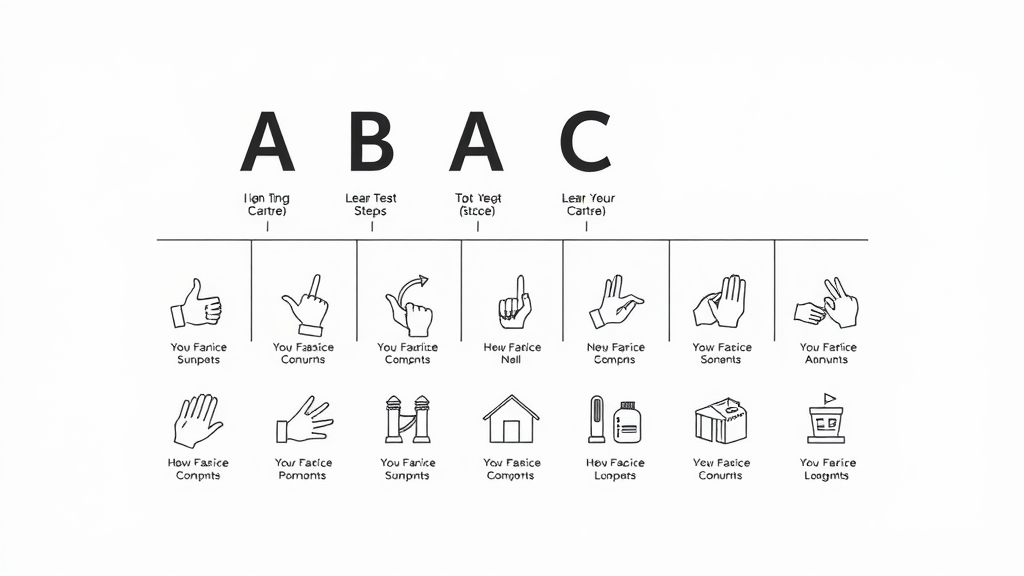Did you know that over 80% of children with autism spectrum disorder see improvements in communication, learning, and behavior through ABA therapy? This is not just a statistic—it's a signpost of hope for families and practitioners alike. The secret lies in mastering the ABCs of ABA: understanding applied behavior analysis and leveraging this powerful model to create real, positive, and lasting change in people's lives. Whether you’re a parent, educator, or aspiring behavior analyst, this guide will equip you to apply these principles for transformative results.

Shining a Light on the ABCs of ABA: Understanding Applied Behavior Analysis with Revealing Statistics
The ABCs of ABA: understanding applied behavior analysis is a science-based approach to understanding how people learn new behaviors and replace those that are unhelpful. With ABA therapy recognized globally as the gold standard for supporting individuals with autism and other behavioral challenges, understanding how antecedents, behaviors, and consequences shape actions becomes critical. Recent studies indicate that ABA, when grounded in the ABC model, not only improves quality of life for children with autism spectrum disorder but also leads to meaningful behavior change for people with diverse needs. These outcomes aren’t just numbers in research—they represent open doors for independence, meaningful relationships, and academic achievement.
- Did you know that evidence shows ABA therapy can improve communication, learning, and positive behavior in over 80% of children with autism spectrum disorder?
- Discover why mastery of the ABCs of ABA: understanding applied behavior analysis can shape positive outcomes for diverse individuals.
Your Roadmap: What You Gain by Understanding the ABCs of ABA and Applied Behavior Analysis

Before you dive deeper, here’s what you’ll learn: The ABCs of ABA: understanding applied behavior analysis unlocks a method for identifying why behaviors occur and how to guide effective behavior change . You’ll learn to spot abc model elements in daily life, create more precise data collection plans, and boost positive behaviors in individuals with autism spectrum and other populations. Perhaps most importantly, you’ll be able to foster better outcomes by combining practical tools like functional behavior assessment with compassionate, actionable strategies.
- Clearly define the abcs of aba: understanding applied behavior analysis and its impact
- Identify the abc model components for precise data collection
- Explore real-world applications in aba therapy for children and individuals with autism
- Grasp proven behavior change techniques using the abcs of behavior
- Learn best practices for behavior assessment and functional behavior assessment that foster positive reinforcement
Core Concepts Explained: The Importance of the ABCs of ABA in Applied Behavior Analysis
Breaking Down the ABC Model: Antecedent, Behavior, and Consequence in Behavior Analysis

At the heart of applied behavior analysis (ABA) lies the ABC model : A ntecedent, B ehavior, C onsequence. The antecedent is what happens right before a behavior—maybe it’s a request from a teacher or the presence of a specific sound. The behavior is the observable action itself, such as a child raising their hand or repeating a phrase. The consequence is what follows the behavior; this could be praise, a reward, or, sometimes, the removal of attention. Understanding how antecedents and consequences influence behavior means you can better predict why certain behaviors occur—and intervene with more effective strategies.
The beauty of the abc model is its simplicity and power—every behavior in aba can be charted using this sequence. By mapping situations in this format, parents, teachers, and ABA therapists can avoid guessing games and instead create structured behavior intervention plans backed by real abc data . As you track repeated patterns, you reveal the “why” behind both challenging and positive behaviors.
Why the ABCs of ABA: Understanding Applied Behavior Analysis is Essential for ABA Therapy Success
The ABCs of ABA are more than an academic concept—they are the key to unlocking effective interventions . When practitioners and caregivers accurately identify the triggers and results of specific behaviors, they’re able to design supports that reduce problematic behavior and reinforce what works. For instance, a behavior analyst using the ABC model can identify that a child’s outburst consistently occurs when transitioning between activities and that calm, predictable cues (antecedents) paired with positive reinforcement (consequences) lead to smoother changes.
Mastering the steps of collecting ABC data and making informed decisions ensures that interventions are tailored, not generic. This approach has led to breakthroughs for countless children with autism and those facing challenges with learning or emotional regulation. Most importantly, the abcs of aba: understanding applied behavior analysis ensures that progress is measured, evidence-based, and genuinely impactful.
Key Elements: Exploring ABC Data, Behavior in ABA, and the Model’s Value
How ABC Data Collection Drives Effective ABA Therapy and Behavior Change

Collecting abc data is the foundation of applied behavior analysis . By systematically noting the antecedents, specific behaviors, and their consequences, practitioners build a clear picture of patterns and triggers. This data-driven approach to aba therapy offers two critical benefits: it takes the guesswork out of what effective interventions actually work, and it empowers everyone involved to celebrate even small steps forward in behavior change . When a behavior analyst tracks these components, it becomes easier to shape the supportive environment needed to drive positive outcomes.
For example, if a child consistently leaves their seat after finishing work (behavior) and gains access to free time (consequence), the therapist or teacher can adjust the antecedent (perhaps offering a visual schedule or verbal cue) and set up a different reward system. The ongoing process of collecting abc shines a spotlight on progress and highlights unique strategies for each child or client.
Understanding Data Collection Techniques for the ABCs of Behavior
Data collection in the context of the abcs of behavior requires consistency, attention to detail, and collaboration. Within ABA therapy , teams use various methods: narrative ABC recording, checklists, or even digital tracking platforms. The critical element is to remain objective—describing only what can be observed and recorded. This objectivity allows for clearer analysis and more effective adjustments to intervention plans .
Effective data collection also enables therapists and caregivers to recognize patterns that may go unnoticed in everyday routines. For instance, small changes in environment or subtle shifts in responses can have a significant impact on both problematic and positive behaviors. With reliable abc model data, families and professionals are better equipped to adapt, reinforce desired behaviors, and foster overall improvement in quality of life .
From Theory to Practice: How the ABCs of ABA Apply to Autism Spectrum and Positive Behavior

Case Examples: Using Applied Behavior Analysis for Children with Autism Spectrum Disorder
The real-world impact of the abcs of aba: understanding applied behavior analysis is perhaps best seen in stories of children with autism spectrum disorder . Consider a young boy who engages in repetitive hand-flapping when overwhelmed. By charting the abc model , the therapist discovers that the antecedent is loud noises during transitions (lunch bell), the behavior is hand-flapping, and the consequence is teacher attention or a classroom break. With this data, the intervention can include noise-canceling headphones and structured transitions with positive reinforcement, leading to a dramatic reduction in the maladaptive behavior and more engagement with learning.
These case studies illustrate how applied behavior analysis goes beyond simple rewards or punishments—it helps families, educators, and behavior analysts see behavior as communication and address the root causes for lasting success.
Promoting Positive Behavior and Reinforcement in ABA Therapy
ABA therapy is highly effective at promoting positive behavior using evidence-based strategies such as reinforcement, cueing, and planned prompts. By focusing on changing the environment and offering motivating consequences for target behaviors, the abcs of aba empowers children and adults alike to build new skills and replace challenging actions with helpful ones. Positive reinforcement —praise, tokens, or preferred activities—becomes a cornerstone for learning, making everyday routines and classroom settings far more supportive.
At the core, these techniques are about equipping individuals to thrive, not just “fixing” problems. They help to create a self-sustaining circle: when new behaviors are taught and reinforced, challenging behaviors decrease, and the positive cycle continues.
- Identify and define target behavior
- Observe and record antecedents and consequences using abc data
- Analyze results for patterns in behavior analysis
- Apply suitable positive reinforcement strategies
- Monitor progress and adapt as needed
| ABC Component | Example (Children with Autism) | Intervention Approach |
|---|---|---|
| Antecedent | Teacher gives instruction | Prompt and visual cue |
| Behavior | Child engages in repetitive action | Task redirection |
| Consequence | Teacher provides praise or time-out | Positive reinforcement/provide break |
"Teaching ‘why’ a behavior occurs—not just ‘what’ happens—using the ABCs of ABA: understanding applied behavior analysis empowers lasting change." – Board Certified Behavior Analyst
Optimization: Leveraging ABA Therapy and Applied Behavior Principles for Behavior Change

Top ABA Therapy Techniques Using ABC Model to Support Individuals with Autism
Leading ABA therapy professionals use the abc model to implement proven techniques such as discrete trial training, natural environment teaching, and behavior contracts. By customizing these strategies to the unique abc data for each client, interventions become more targeted and effective—maximizing gains in language, self-care, and social interaction for individuals with autism .
Collaboration is critical: successful programs integrate input from families, teachers, and related service professionals. This partnership ensures that behavior change facilitated by the abc model is consistent not just in a therapy room, but at home and in community settings.
Monitoring Progress: ABC Data Collection and Behavior Analysis Best Practices
- Track behavior change through structured abc data sheets
- Utilize visual analytics to identify improvement
- Integrate applied behavior approaches with family and school collaboration
Continuous monitoring of behavior in ABA through meticulous data collection forms ensures long-term success and allows swift adjustments to intervention plans. Regular reviews by a behavior analyst ensure strategies remain aligned to the evolving needs of children with autism or other populations, driving lasting success and quality of life improvement.
Teams that prioritize strong documentation and ongoing collaboration consistently see greater outcomes in their clients, highlighting the crucial role of quality abc data in effective behavior analysis.
Behavior Assessment: Functional Behavior Assessment and Spectrum Disorder Insights

Designing Effective Behavior Assessments with the ABCs of Behavior
Conducting a thorough behavior assessment grounded in the abc model is the first step toward effective intervention . By identifying target behaviors, collecting precise abc data , and analyzing patterns, you can determine whether behaviors are triggered by sensory input, social interactions, or environmental changes. This level of understanding prevents mislabeling or misinterpreting actions and ensures every strategy is rooted in observable evidence.
It’s important for parents and professionals alike to be patient and intentional during assessment. Not every behavior can be changed overnight—but with clarity around antecedents and consequences, even long-standing challenges can be addressed incrementally and compassionately.
Harnessing Functional Behavior Assessment in ABA for Autism Spectrum Disorder
Functional behavior assessment (FBA) tools help identify the root causes behind problematic behavior in autism spectrum disorder and other diagnoses. The process involves observation, abc data collection , interviews, and sometimes formal assessments. With the right insights, interventions such as structured visual supports, scheduled breaks, or sensory adjustments can be introduced—leading to meaningful reductions in maladaptive behavior and increases in independence.
When an FBA is part of ongoing aba therapy , families and therapists can work together with confidence, knowing that each step is informed by data and guided by the principles of applied behavior analysis .
Practical Strategies: Implementing the ABCs of ABA for Positive Reinforcement and Lasting Impact
- Define observable behaviors
- Gather abc model data
- Analyze findings to determine triggers (antecedents)
- Use positive reinforcement to shape desired behavior
- Review and optimize interventions regularly

Whether in the classroom or at home, these practical steps can radically transform approaches to behavior for individuals with autism spectrum and beyond. Clearly defined targets, reliable data, patterned analysis, and consistent follow-up are the building blocks that make applied behavior analysis work—empowering families and professionals to support behavior change that lasts.
What are the ABCS of behavior in ABA?

The ABCs of Behavior in ABA Explained: Antecedent, Behavior, and Consequence
The abcs of behavior in aba stand for Antecedent (what happens before the behavior), Behavior (the actual action observed), and Consequence (what happens immediately afterward). This model is the backbone of applied behavior analysis , enabling individuals and teams to understand not just what behavior occurs, but why it happens. By systematically identifying these three components, it becomes easier to intervene, reinforce, and support positive changes across settings.
Understanding the ABCs is foundational to successful interventions—creating actionable pathways for families, teachers, or behavior analysts seeking concrete improvement in everyday life.
What is the ABC pattern in ABA?
Defining the ABC Pattern: Sequence of Events in Applied Behavior Analysis
The abc pattern in aba is a method for recording and analyzing a sequence of events : tracking what specifically prompts a behavior (antecedent), what the exact behavior is, and what follows immediately as a result (consequence). This sequential approach creates clarity around how behaviors occur and evolve—making it possible to predict, shape, and reinforce desirable behaviors consistently.
Many professionals rely on the abc pattern as a day-to-day tool not just for intervention, but also for teaching self-monitoring skills to individuals with autism and other special needs.
What is ABC design in ABA?

Structure of ABC Design and Its Relevance in ABA Therapy
ABC design in the context of aba therapy refers to the structured approach for designing, implementing, and evaluating behavioral interventions. This process starts with identifying the antecedent, defining the behavior, and mapping out the consequences. It then uses this framework to create targeted plans that address problematic or maladaptive behavior and encourage positive behavior .
The major strength of this design is its flexibility—it can be adapted for classroom routines, home life, and even community settings. Whether your goal is to increase communication, reduce self-injury, or simply create smoother transitions, the abc design’s stepwise, evidence-based process is the backbone of effective intervention .
What is the ABC report in ABA?
Understanding the ABC Report: Recording and Interpreting ABC Data
An ABC report in applied behavior analysis is a systematic log used to record specific instances of behavior, including the antecedents and consequences tied to each event. These reports are critical for capturing the context in which behaviors occur , allowing behavior analysts and families to spot trends and tailor their intervention strategies accordingly.
Well-maintained reports not only bolster intervention efforts but also provide valuable historical data for future planning, making them essential tools in the long-term support of children with autism spectrum disorder and individuals with various behavioral needs.
Essential FAQs: The ABCs of ABA and Applied Behavior Analysis
-
How does the abcs of aba: understanding applied behavior analysis differ from other behavior change models?
While other models focus primarily on motivation or punishment, ABA uses objective data—through the abc model—to understand the function of behavior, targeting both triggers and outcomes for long-lasting change. -
Who can benefit from learning the abcs of behavior analysis?
Anyone striving to encourage new skills, reduce challenging behavior, or enhance quality of life—including parents, teachers, therapists, and individuals with autism spectrum disorder. -
When should abc data collection begin in aba therapy?
Ideally, data collection should begin before interventions to create a baseline and continue throughout the process for ongoing assessment and optimization. -
What are some common challenges with implementing the abc model in real-life settings?
Consistency, accuracy, and collaboration can sometimes be difficult—especially with multiple caregivers or changing environments—but regular training and open communication can overcome these hurdles. -
Where can families find resources for applied behavior analysis and the abcs of aba?
Reach out to certified behavior analysts, local autism organizations, and online guides for templates, further reading, and support networks specializing in ABA therapy.
Checklist for Success: Getting the Most Out of the ABCs of ABA in Therapy and Daily Life
- Complete a behavior assessment using the abc data approach
- Regularly review progress with your behavior analyst
- Update abc model records when new behaviors emerge
- Collaborate with teachers, therapists, and caregivers for consistent support
Summary & Insights: The Lasting Value of Mastering the ABCs of ABA—Understanding Applied Behavior Analysis
"The abc model provides the foundation for understanding, analyzing, and transforming behavior in aba therapy—and empowering individuals to thrive."
Take the Next Step with Applied Behavior Analysis: Resources and Contact
- Access in-depth guides and abc data templates
- Get a professional applied behavior assessment today
- Discover community organizations supporting children with autism and spectrum disorders
Ready to put the ABCs of ABA into practice? Connect with an ABA specialist or download our free ABC data collection template today!
To deepen your understanding of the ABCs of Applied Behavior Analysis (ABA), consider exploring the following resources:
-
“The ABCs of ABA - ABA Insight” : This article provides a comprehensive breakdown of the Antecedent-Behavior-Consequence model, detailing how antecedents trigger behaviors and how consequences can be managed to encourage positive change. ( abainsight.net )
-
“Understanding the ABCs of ABA Therapy: Antecedent, Behavior, and Consequence” : This resource offers practical examples of the ABC model in action, illustrating how antecedents and consequences influence behavior and how they can be adjusted to promote desired outcomes. ( rainbowtherapy.org )
These articles will provide you with practical insights and strategies to effectively apply the ABC model in various settings.
 Add Row
Add Row 

 Add
Add 


Write A Comment